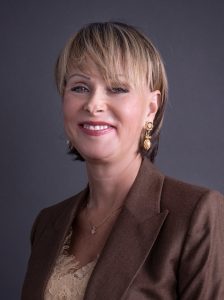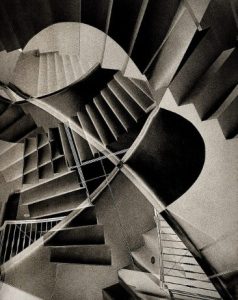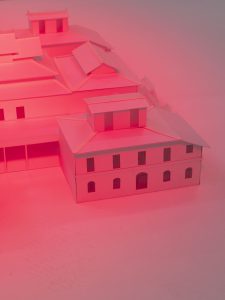מבקרים הנכנסים למיצב של יונתן אולמן שומעים את צלילי צעדיהם היטב. הרצפה מורכבת משברי קירות הסטודיו שהיה לאמן בניו יורק. היא עכורה מסוליות נעלים, פינה ועוד פינה ננגסות – נגרסות תחת משקל הצופים. על קיר מתנוסס באותיות כתב אדומות “מי לא”, חצי מהכיתוב “מי ציוני ומי לא” שכתב
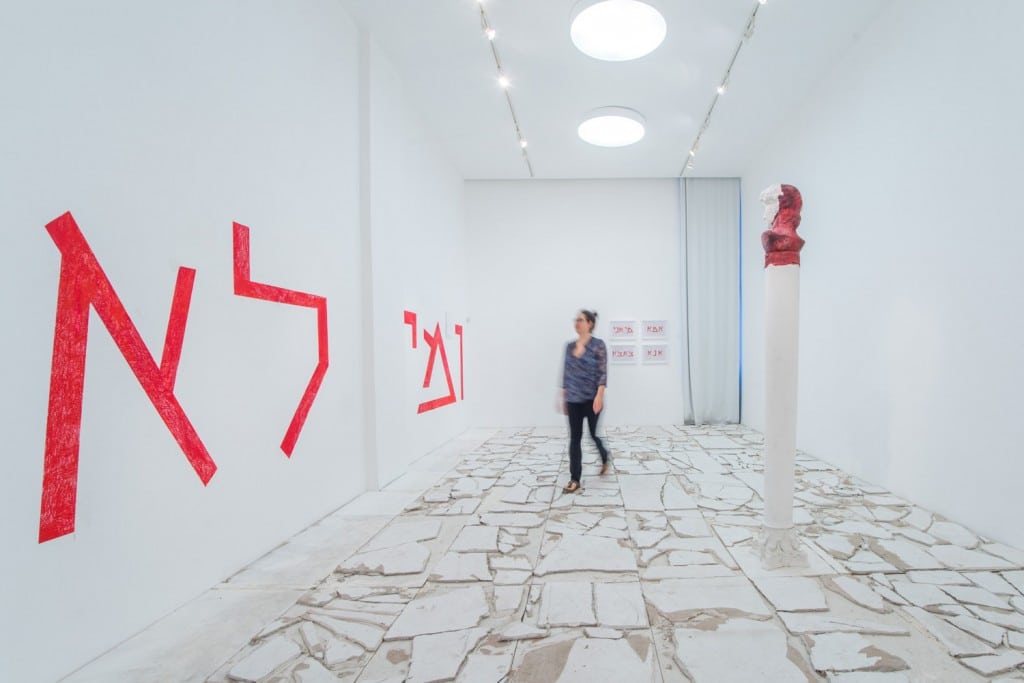
photo Barak Brinker
גרשוני על קירות גלריה גולי מ. ב 1979. השאלה הדהדה את השסעים העמוקים שצפו ועלו למודעות הציבורית אחרי עליית הימין לשלטון ב 1977 והמחלוקת העזה סביב מחיר הסכם השלום עם מצרים. החלוקה הדיכוטומית למחנות, “הלנו אתה או לצרינו” (שאלה ששואל יהושע בן נון מלאך הנגלה אליו לפני הקרב על יריחו), מחיקת האפשרות למורכבות עולה בחריפות מעבודת הטקסט של גרשוני. אולמן, עשרים ושש שנים לאחר העבודה של גרשוני, משאיר אולמן רק את “מי לא” – ההדרה כפרקסיס.

האסוציאציה החזותית המידית, המעיקה, למיצב של אולמן היא GERMANIA, עבודת מפתח של הנס האקה Hans Haacke שהיוותה את הביתן הגרמני בביאנלה בוונציה ב 1993. האקה שבר וניתץ את רצפת השיש של הביתן ועל קירות האולם הפנימי נכתבה המילה GERMANIA. בפתח הביתן נתלתה תמונתו של היטלר בביתן, והעתק של מטבע מארק גרמני (ימי הטרום אירו) נתלה מעל לכניסה.
GERMANIA, השם היווני רומי לאזור גיאוגרפי נרחב (שבתוכו גם גרמניה המודרנית) צופן את זיכרון המיתולוגיה הטבטונית והשאיפות של היטלר לעיצוב העולם אחרי ניצחונו. GERMANIA היה אמור להיות שמה של ברלין לאחר הניצחון הנאצי, עיר שתוכננה לגלם, בקנה מידה גיגנטי את העוצמה הנאצית. האקה האיר את הקשר בין האמנות הגרמנית שהביתן אתר חשוב שלה, לבין הנאציזם וזאת בעת שגרמניה ביססה את מקומה כמייצגת חופש וסדר חדש לאחר נפילת החומה ואיחוד גרמניה.
ביקורו הראשון של היטלר מחוץ לגרמניה לאחר בחירתו כקאנצלר ב 1933 היה לאיטליה. כחובב אמנות היה הביתן הגרמני בין אתרי הביקור. היטלר ציווה על בניית ביתן חדש והורה שתהיה בו רצפת שיש (במקום פרקט שהיה בביתן שנהרס). הביתן שבנה, והמשמש את גרמניה עד היום ,נחנך ב 1938. האקה יצר אנדרטה מצמררת להיסטוריה, לדרך בה שפה טוטליטרית מתאזרחת.
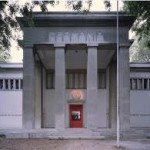

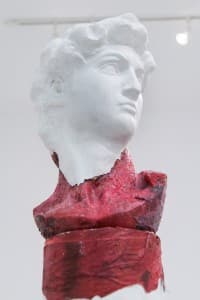
photo Barak Brinker
במיצב של אולמן הערה על קיטש וכוח עם עמוד “קלאסי” הפוך המשמש פדסטל להעתק ראש דוד של מיכאלאנג’לו 1501-1504. הפסל היה סמל החופש והאידיאלים הרפובליקאים של פירנצה. אולמן צבע את חלקו האחורי של הראש באדום דם כשל הטקסט (שלו ושל גרשוני ).
סמל פצוע על רצפה מתפוררת מול טקסט מבשר רעה והזיכרון המובלע של דיסטופיות כוח מחרידות.
הרשמה לניוזלטר הפירסומי השבועי של “החלון” בנושאי אמנות, אירועים ותערוכות חדשות – www.smadarsheffi.com/?p=925 (הרישום נפרד מהרישום לבלוג )
A look at Yonatan Ullman’s Legacy
Visitors to Yonatan Ullman’s one-person exhibition hear their footsteps loud and clear. The floor is paved with fragments of the drywalls from the artist’s NYC studio, bearing marks from shoes andchipped away at the corners under the weight of visitors. On the wall in big red letters are the words “who is not,” half of Gershuni’s 1979 wall piece shown at Julie M.

The first part of the question, “Who is a Zionist,” resonated through the deep rifts in Israeli society following the Right’s victory in the 1977 elections and arguments over the price of peace with Egypt. The dichotomy in Israel between the two camps with no option for complexity arises from Gershuni’s textual work. Twenty-six years later, Ullman leaves only “who is not” – exclusion as praxis.
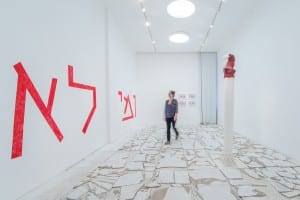
photo Barak Brinker
The immediate and distressing visual association to Ullman’s installation is Hans Haacke’s key work Germania, installed in the German pavilion in Venice at the 1993 Biennale.Haacke shattered the marble floor of the pavilion and inscribed the word “Germania” on the inner wall, with a picture of Hitler hung on the door and a replica of the pre-Euro German mark hanging over the entrance.
Germania, the ancient Greco-Roman name for a broad geographical expanse (encompassing modern Germany as well), encodes the Teutonic mythological memory and Hitler’s ambition to create a new world order. Germania was to be the name of Berlin after the Nazi victory, designed to embody the Nazi power. Haacke illuminated the link between German art and the German pavilion – an important site for it–and Nazism, while Germany has fashioned itself as the representative of freedom and liberty after its reunification and the fall of the Berlin Wall.

Hitler’s first foreign visit as chancellor was to Italy, in 1933. An art lover, he visited the German pavilion, among other sites, and ordered the construction of a new pavilion. The new building was to have a marble floor instead of parquet; inaugurated in 1938, it is still used today.Haacke created a chilling monument to history and the way in which totalitarian language has become part of the civic discourse.
Ullman’s installation makes a comment on kitsch and power with the “classical” pillar on its head, made into a pedestal for the copy of the head of Michelangelo’s David (1501-1504).

photo Barak Brinker
The statue was the symbol of the ideals of freedom of the Republic of Florence; Ullman painted the back of the head in the same blood-red of his (and Gershuni’s) text.
The combination of the wounded symbol of David on a crumbling floor, a text boding ill, and the covert memory of a dystopia of power generates anxiety.
Join the mailing list for Window’s weekly informational advertising newsletter –
www.smadarsheffi.com/?p=925
Comments – please write to thewindowartsite@gmail.com

